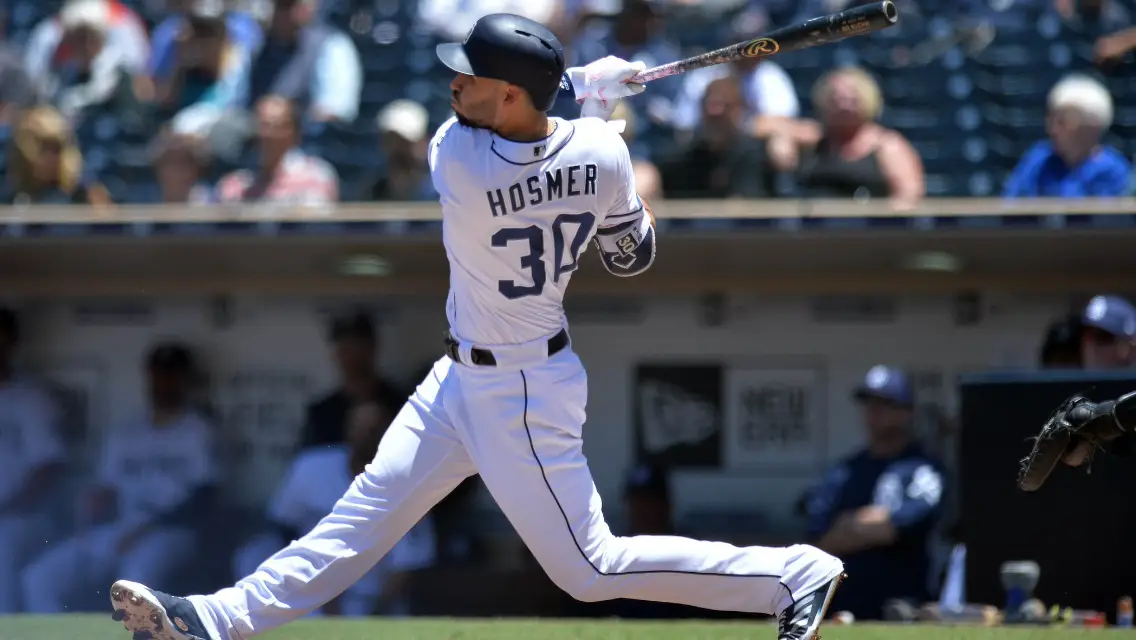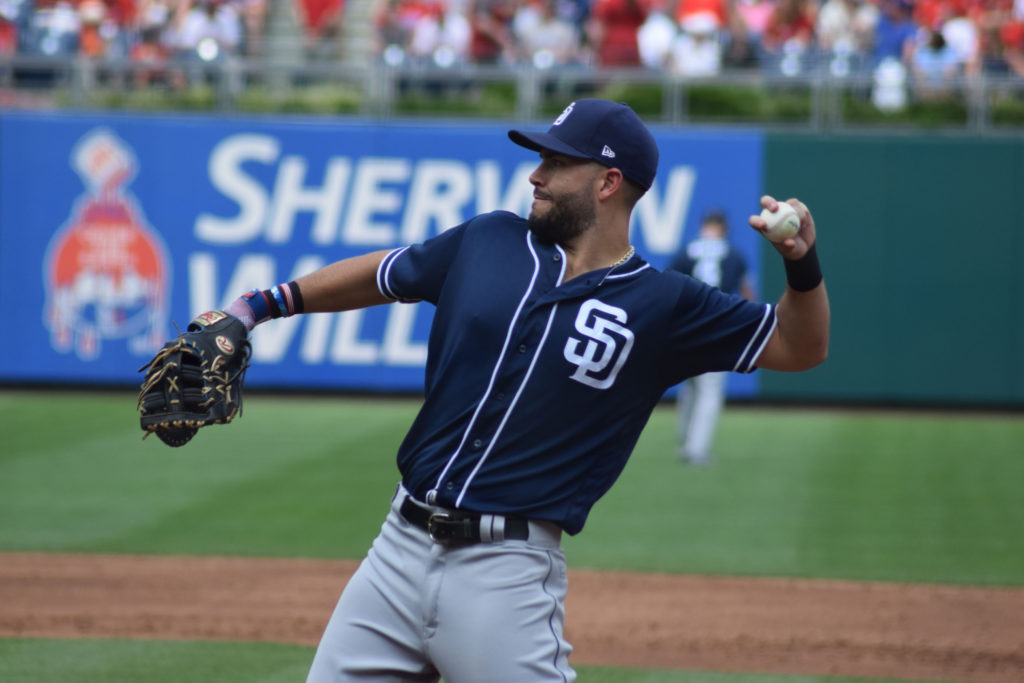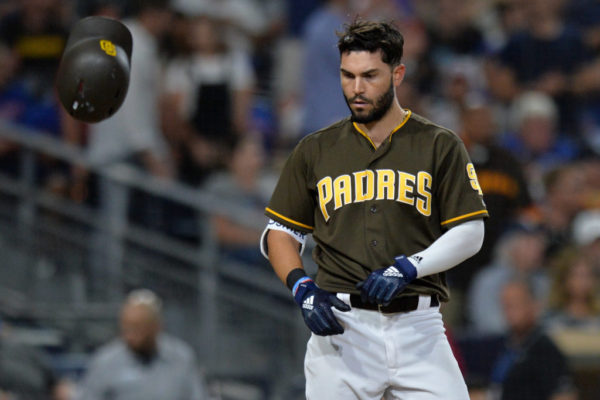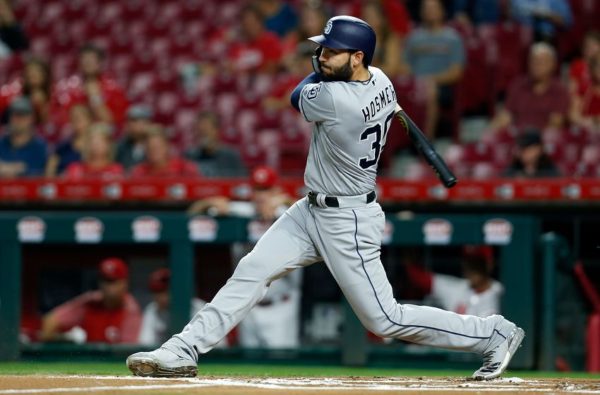Padres PNO (Positives/Negatives/Outlook): Eric Hosmer

Credit: Padres

In last year’s strangely inactive offseason, the Padres made one of the bigger splashes by signing first baseman Eric Hosmer to the largest contract in the organization’s history. On February 19th, Hosmer agreed to a $144 million deal with an opt-out after five years. He’ll take home $21 million a year through 2022.
By signing Hosmer, the Padres indicated some frustration with Wil Myers, who had been acquired in general manager A.J. Preller’s trade fest early in his tenure. Myers had manned first the previous two seasons (149 games in 2016 and 154 in 2017).
Hosmer’s original team, the Kansas City Royals, made some effort to retain his services, but no other organization entered the bidding. Hosmer’s agent, Scott Boras, hyped his player to the skies, emphasizing his “prestige value” (whatever that is) at the Winter Meetings. The Padres obviously bought into the hyperbole. Hosmer’s first season had mixed results.
Positives
Hosmer did bring his experience in Kansas City with him. He won a World Series ring with the Royals at the ripe old age of 25 playing alongside several other home-grown players. In 2010-11, Hosmer’s first and second years, the team won just 71 and 72 games. By 2013, the Royals improved to an 86-76 record, but still only finished third in the American League Central. Hosmer has experienced both the highs and lows in the march toward the ultimate goal.
The Padres acquired Hosmer coming off his best season in the big leagues. He played every single game in 2017 and finished with a batting line of .318/.385/.498/.882. Although his on-base percentage didn’t come close to the league leaders, it did surpass the team’s overall (and MLB’s lowest) of .297 OBP.
In an era of launch angle, Hosmer hasn’t tried to alter his approach at the plate. In his career, he’s been an above-average hitter, and, rather than trying to reinvent his swing, he stuck with what has worked. However, this year he actually had the third-lowest launch angle since the creation of Statcast, an analytical tool. He also had the fifth-highest groundball rate of all hitters at 46.5 percent.
With the Padres, Hosmer again proved to be durable by appearing in 157 games. He also played a serviceable first base. Although he has won four Gold Gloves, including one in 2017, stats give a confusing picture of his defensive abilities. In his fourth Gold Glove year, he actually had -7 DRS (defensive runs saved). According to FanGraphs advanced defensive stats for this year, Hosmer ranked 17 of first baseman overall with -14.4 Def, -2.0 UZR/150, but he also had 8 DRS.
In his first year in San Diego, Hosmer led the team in most offensive categories, including batting average .258, RBI 69, and OBP .322. However, those numbers pale in comparison to the National League offensive leaders: Christian Yelich of the Milwaukee Brewers with a .326 average, Javier Baez of the Chicago Cubs with 111 RBI, and Joey Votto of the Cincinnati Reds with a .417 OBP.

Known for his leadership abilities and other intangibles, Hosmer has provided a contrast to the hot free agents of this season. He’s certainly no Bryce Harper or Manny Machado in terms of attitude or reputation and appears to relish his role in San Diego.
Negatives
At this point, the negatives of the Hosmer acquisition tend to outweigh the positives, especially when his salary is taken into account. The Padres opted to make the biggest salary commitment in the organizations for a first baseman, which is not a premium defensive position. Positions up the middle — catcher, center, and shortstop — are generally considered be the most crucial and require more agility, skill, and/or speed than first.
By comparison, a relatively unknown guy named Max Muncy ended up playing first base for the Los Angeles Dodgers when injuries required Cody Bellinger’s move to center field. The journeyman batted .263/.391/.582 and earned just $545,000 this year.
By bringing in Hosmer, the front office created the difficult situation that must be addressed this offseason — the crowded outfield and third base conundrum. The acquisition involved moving Wil Myers to third base where he has no comfort level, having never played the position. The team also transferred the “face of the franchise” label from the former to the new guy, not exactly a team-building strategy.
Aside from the Padres, only the Royals made a bid for Hosmer’s services. We have to ask this question: did Preller get played by Scott Boras? Ironically, Dave Cameron the former managing editor for FanGraphs and now an employee in the Padres’ front office, issued a dire warning about just such a deal. In November last year, Cameron named Hosmer as the number one “Free-Agent Landmine(s).” Cameron considered a contract in the $80 to $90 million range to be appropriate.
Hosmer’s OPS+ fell from an all-time high of 133 in 2017 to 99 this year. In 2017, he hit 25 home runs. In San Diego, he hit 18 home runs and also had fewer walks (down from 9.8 percent to 9.2 percent) and more strikeouts (up from 15.5 percent to 21.0 percent) than the previous year.
Leadership cannot necessarily be transferred from team to team. The Kansas City Royals called Hosmer up in at the age of 21. He came up through the ranks with other players on the team. However, it’s a vastly different scenario when a player lands in on a new team. Leadership and team building tend to occur organically, not be forced from above.

The latest research indicates that baseball players tend to peak around 27 to 29 and decline thereafter. Eric Hosmer turned 29 in October. Since the Padres don’t count on contending until 2020 or later, Hosmer will be on the downside of this trajectory by that point.
Although the Padres have never been big spenders, the current ownership group has assured fans that the team will invest in players. But San Diego can never hope to compete dollar-for-dollar with the truly wealthy organizations. A contract like that awarded to Hosmer is more risky for a team like the Padres.
Outlook
Although Hosmer’s first year has been disappointing, he certainly could have been pressing and trying to live up to the gaudy numbers on his paycheck. Also, in his time with the Royals, he alternated productive and less productive years at the plate. In 2019, he could rebound and resemble the player the Padres thought they’d signed.
Would the Padres have been better off keeping their powder dry for another year or two, especially in light of the fact that no one expected the 2018 team to be competitive? The same also applies to 2019.
Trade rumors, which mean next to nothing, indicate the Padres may be shopping Myers. If the team can manage to trade him, Myers may be better off elsewhere, and the Padres would clear one roster spot.
In a more perfect world though, the Padres would have kept Myers at first, saved $144 million, and put that money toward other needs at more crucial positions than first base. In San Diego Myers has batted .252/.330/.454/.785, Hosmer .280/.340/.433/.773.
That $144 million could have been spent more wisely, specifically for a real third baseman as well as a front-line starting pitcher.
Baseball has been a part of Diane’s life since her father played professionally (mostly at the minor league level). She has written for a number of publications and concentrated on companion animal welfare. She welcomes the opportunity to write about the sport she loves. Diane shares her home with her husband and a house full of rescued animals.
I’m a KC fan for 30 years. I’ve seen the best. I watched hosmer come up at age 20 watched him for a few months and I told my wife that if he didn’t change his swing he’ll be done by 30. I still believe that. Not only the launch angle but it’s too long and his stride is too wide. He pretty much has a 360 degree swing. He swings from ear to ear. What happens when his swing slows down just a bit. I think it already beginning. I’m not saying he won’t have another good year or two but his best years are behind him because he won’t adjust. I’m just glad the padres have him and not us
Your comments are much appreciated and on the mark. A platoon could be the answer because of Hosmer’s splits. But the idea of including Myers in the platoon is a really good idea. Of course, both of these acquisitions and their cost, Myers and Hosmer, have come back to haunt the front office. However, nothing will solve Myers’ dreadful defense at third…
You’ve hit all the right notes. Preller drank the kool-aid. No other team made an offer (KC was talking deal, but ownership would not sign off on it, so no formal offer was ever made) thus SD bid against itself for a player no other team wanted. Paying for “leadership” is embarrassingly dumb.
Now. what to do?
In a perfect world you would move to trade Hosmer. Here’s how it might work: As Hosmer has bad platoon splits, as Greg mentioned, against RHP it’s Hosmer at 1B and Myers at 3b, but against LHP it’s Villanueva at 3b and Myers at 1b. This is the most potent alignment, but it’s really designed to force Hosmer’s hand into one of two actions: to change his freakin’ swing and hit the ball in the air, or to waive his no trade clause so we can dump him on another team.
Since the front office is unlikely to have the nerve for this, the second scenario is simply to trade Myers and hope that Hosmer makes the swing change on his own.
But going forward ownership needs to recognize the immense stupidity of the Hosmer signing and to prevent this kind of mistake from happening again. Perhaps the hiring of another baseball guy to replace Mike Dee would have been the balance needed to avoid this blunder. That can still be done.
Good article. I really think that Hosmer’s signing was misplaced (and that’s not intended as anything personal; from what I’ve seen, he’s a fine person and a good teammate). It’s just that as a small-market team, the Padres have to be very picky about which free agents they should splurge on.
Another thing about Hosmer: his L-R splits were very noticeable: .295/.368/.462 vs. Righties, .179/.240/.287. Maybe a platoon situation with Christian Villanueva is in order?